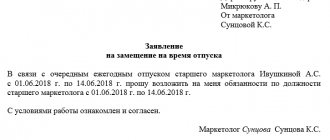According to the Labor Code of the Russian Federation, the chief accountant does not belong to ordinary employees; this position is one of the key ones in the enterprise. Since key business functions are concentrated in the hands of a specialist, the dismissal of an accountant requires a special procedure for transferring cases. This process takes place in several stages and involves introducing a new specialist to the financial situation of the enterprise, conducting an inventory and accepting documents, completed by signing the act.
Article navigation
Dismissal of the chief accountant - transfer of affairs
The nuances of building labor relations with the chief accountant are discussed in the Labor Code of the Russian Federation, as well as in Federal Law No. 129 “On Accounting”. An order to remove an employee from a position is issued by the General Director.
Termination of the contract takes place on a general basis:
- at your own request;
- leadership initiative;
- reasons associated with financial liability.
Termination of employment relations at the initiative of the director is permitted if there are compelling reasons:
- objective - staff reduction, liquidation of the enterprise;
- subjective - expiration of the contract, provision of inaccurate data at the time of joining the company, failure to fulfill direct duties, absenteeism, appearing intoxicated at the workplace, etc.
The chief accountant can also be fired if the fact of theft, embezzlement or damage to the property of the enterprise has been established.
Familiarization with the job description and order for the transfer of cases
The new chief accountant needs to clearly understand his job responsibilities in order to organize his work and understand what to pay attention to when accepting cases from a departing specialist.
To do this, the new chief accountant should read the job description. Unfortunately, many companies simply do not have such documents. And although this is a gross violation of personnel records, such cases are not uncommon. And it is during the transfer of affairs that management draws attention to the fact that job descriptions are an integral part of a properly organized business. Without them, personnel changes can be very painful for the enterprise. So we recommend that you pay special attention to the order in personnel documents and check whether all positions have job descriptions and whether all employees are familiar with them.
The transfer of cases is carried out on the basis of an order from the head of the organization. The document must indicate the last name, first name and patronymic of the person accepting the affairs (new chief accountant), the person transferring the affairs (former chief accountant), as well as the names of other employees involved in the transfer of affairs (manager, auditor, secretary).
The order should indicate: the reason for the acceptance and transfer of cases - for example, the dismissal of the chief accountant; the timing of the acceptance and transfer of cases and the period during which this procedure will be completed. If the chief accountant resigns of his own free will (clause 3 of Article 77 of the Labor Code of the Russian Federation), then the employer has two weeks to terminate the employment contract in accordance with Article 80 of the Labor Code. In this case, it is advisable to set a period of two weeks. In addition, the order must indicate the name of the employee responsible for the transfer of cases (last name, first name and patronymic of the outgoing chief accountant), and the name of the employee responsible for the reception (last name, first name and patronymic of the new specialist). Be sure to name each member included in the commission, as well as the chairperson of the referral committee. A commission is created if a large volume of documents is subject to transfer. It may include accounting employees, internal control services, security services and other employees. When creating a commission, responsibility for organizing and conducting the transfer of cases rests with the chairman of the commission. Among other things, do not forget that the order must indicate the deadline for drawing up the act of acceptance and transfer of cases.
How to transfer affairs upon dismissal of the chief accountant?
In any case, when the chief accountant is dismissed from the company, the procedure for accepting and transferring cases is carried out on the basis of the order of the director. The document is drawn up in any order and includes the following information:
- the Labor Code article under which the specialist was dismissed and the date;
- deadlines for verification and transfer of cases;
- members of the commission responsible for conducting the inspection;
- information about the party receiving the case;
- signatures of the parties and seal.
Cases are transferred to a new chief accountant, deputy or head of the company. The procedure takes place in 6 stages.
Stage 1. Study of the job description and order for the transfer of cases
A specialist entering a position must understand exactly what his responsibilities are at his new place of work. To obtain the most reliable information, the new employee gets acquainted with the job description and the manager’s order on the transfer of documents upon dismissal of the accountant.
Stage 2. Taking inventory
Before changing the chief accountant, they usually organize an inventory, during which they check goods, materials, fixed assets, the state of the cash register, and settlements with contractors. The results of the inventory are attached to the act of acceptance and transfer of cases.
Stage 3. Checking the status of accounting and reporting
The incoming specialist checks the status of accounting and tax records, as well as all types of reporting. During the procedure, he evaluates:
- constituent and registration documents;
- information about the company's accounting policies;
- primary documentation;
- reports on financial activities and tax payments;
- reporting to extra-budgetary funds;
- acts of reconciliation with tax authorities;
- inventory based on inventory;
- cash documents and bank statements;
- documents related to personnel;
- job descriptions for ordinary accountants.
All documents are filed. If some of the papers are missing, a record of this is made in the transfer and acceptance certificate. After the documents for the dismissal of the chief accountant have been verified, the new responsible person becomes acquainted with the accounting policies of the enterprise on tax and accounting issues for the last 2 years. It also checks the compliance of the current financial policy of the enterprise with the law. At the same time, the employee studies whether taxes and contributions were calculated correctly, whether declarations and calculations were submitted on time.
Serious assistance in analyzing cases is provided by a selective study of primary documentation. It is also useful to familiarize yourself with the conclusions of auditors and reports on the results of inspections. This part of the work will make it possible to understand what mistakes were typical for the previous chief accountant.
Stage 4. What the chief accountant conveys upon dismissal: basic documents
Now let's touch on what an accountant must convey upon his dismissal. We are talking about documents that reflect the specifics and results of the company’s activities:
- constituent documents (charter, extract from the Unified State Register of Legal Entities, certificate of registration);
- documents on the organization of accounting (accounting policies, chart of accounts, job descriptions);
- accounting and tax registers;
- accounting and tax reporting (declarations, reports, accounting journal);
- orders for inventory and inventory;
- documents on relations with the tax authorities (acts of inspections and reconciliations with tax authorities);
- documents on accounting of fixed assets (order on the creation of a commission, acts of acceptance and transfer on the OS-1 form, inventory cards);
- documents for inventory accounting (material accounting cards, receipt orders, invoices);
- documents on cash accounting (cash book, receipt and debit orders, payment orders, bank account statements);
- documents on personnel (employment contracts, orders for hiring and dismissal, pay slips);
- agreements with suppliers and clients, reconciliation reports with creditors;
- primary documents and accounting statements;
- strict reporting forms;
- powers of attorney, travel documents.
Stage 5. Receiving clarifications from the resigning chief accountant
Procedures related to the transfer of affairs accompanying the dismissal of the chief accountant also include written or oral explanations for the new employee. The information provided usually contains information about the procedure for maintaining accounting and tax records, features of interaction with other divisions of the company, suppliers and creditors.
Stage 6. Drawing up and signing the act of acceptance and transfer of cases
It is mandatory that the transfer of documents upon dismissal of the chief accountant is enshrined in the act. The document is compiled in as much detail as possible to reflect the financial condition of the enterprise at the time a new specialist takes office. The act is filled out in any form and includes comprehensive information:
- Full name of the persons who submit and accept cases;
- date of transfer of responsibilities;
- date and number of the order for the acceptance and transfer of cases;
- names and number of documents submitted;
- series and numbers of checkbooks, strict reporting forms;
- information about lost documents;
- errors identified by the check;
- number of transferred seals and stamps;
- The latest report from external auditors on the reliability of the financial statements.
Also, the act of acceptance and transfer of cases includes characteristics of accounting and tax accounting. It contains sections:
- on the organization of accounting with a detailed analysis of accounting policies and the level of automation of basic processes;
- cash accounting with a list of all current accounts belonging to the company;
- accounting of fixed assets and intangible assets;
- accounting of raw materials and finished products based on inventory results;
- settlements with suppliers and clients, the Federal Tax Service, extra-budgetary funds;
- financial statements with discrepancies between the data from the reports and information from accounting and tax records;
- storage and destruction of documents.
Instructions for drawing up a document
The order is drawn up in the generally accepted form, but there are some differences from other documents for the enterprise .
Form
The legislation has not developed a special form for such a document, which means freestyle. Like any other, such an order is printed with the company details and address at the top of the sheet.
Below in the center is the name - the order, on the next line on the left indicate the point where the change of chief accountant takes place and the company is located, and on the right - the date.
On the left, a short column describes the topic of the document, in this case it looks like this: “Concerns the transfer of affairs by the chief accountant.” Below, with a paragraph, the text part of the document begins.
Responsibility of the chief accountant after dismissal
Responsibility for the formation of the organization's accounting policies and timely submission of reports, as well as the absence of errors in them, remains with the chief accountant for another year after dismissal. Such instructions are given by Federal Law No. 129. The amount of fines is regulated by Chapter 15 of the Code of Administrative Offences:
- for late submission of reporting documents - 300–500 thousand rubles;
- gross violation of accounting rules - 2-3 thousand rubles.
An employee may be brought to criminal liability for large-scale tax evasion. For such violations, accountants are punished with a fine of up to 500 thousand rubles. or imprisonment for up to six years. In addition, the specialist does not have the right to hold a similar position for three years.
The accountant also bears financial responsibility to the company's management. The former employer may demand compensation for damage caused during the performance of professional duties (under Article 238 of the Labor Code of the Russian Federation).
Additional taxes, penalties and fines are accepted for actual damage. The statute of limitations for bringing financial liability is limited to one year after dismissal. In addition, this opportunity must be indicated in the employment contract with the chief accountant.
The procedure is carried out in court and requires the provision of evidence:
- employment contract;
- payment documents;
- inspection reports of supervisory authorities.
Results
The act of acceptance and transfer of cases when changing the chief accountant is drawn up in any form. Its content includes all important aspects for this procedure (reflection of the facts of the transfer of documents, description of accounting and reporting nuances, etc.).
Sources
- https://kakzarabativat.ru/pravovaya-podderzhka/smena-glavnogo-buhgaltera/
- https://lavnikpartners.com/articles/kak-uvolit-glavnogo-buhgaltera/
- https://fin-az.ru/426583a-akt-priema-peredachi-del-glavnogo-buhgaltera-obrazets-smena-glavnogo-buhgaltera
- https://moyafirma.com/shtat/hr/kadrovoe-deloproizvodstvo/uvolneniya-personala/glavnogo-buhgaltera/kak-peredat-dela.html
- https://kakzarabativat.ru/pravovaya-podderzhka/uvolnenie-glavnogo-buhgaltera-i-peredacha-del/
- https://lavnikpartners.com/articles/priem-peredacha-del-i-dokumentov-pri-uvolnenii-buhgaltera/
- https://vashbiznesplan.ru/bukhgalteriya/kak-peredat-dela-glavnogo-buxgaltera.html
- https://nalog-nalog.ru/buhgalterskij_uchet/dokumenty_buhgalterskogo_ucheta/akt_priemaperedachi_del_glavnogo_buhgaltera_obrazec/
- https://Zapusti.biz/baza/uvedomlenie-nalogovoj-o-smene-glavnogo-buhgaltera
- https://zhazhda.biz/base/uvedomlenie-o-smene-glavnogo-buhgaltera
What to do if the accountant did not hand over the documents upon dismissal?
Situations cannot be ruled out when the chief accountant leaves at an inopportune moment, for example, during the period of receiving requests from tax authorities. Checking documents in case of sudden dismissal of the chief accountant is the smallest part of the task. Typically, this situation threatens with serious penalties from supervisory authorities.
There is one more feature. If 2 weeks of work have passed and a deputy has not been found, it is impossible to force the former chief accountant to come and hand over the documents. The reasons for not wanting to return to your previous place are not important.
What should the deputy do if the accountant did not hand over the documents upon dismissal?
It is most logical to immediately draw up an inventory of available documents in order to draw a dividing line between the activities of the previous official and your own, as well as to get up to speed and have an idea of what papers are on hand in order to promptly provide them to tax officials.
If managers or the new chief accountant have reason to suspect that serious errors may have been made in the management of tax and accounting records, it is best to conduct an audit and, based on its results, eliminate the bottlenecks found.
Who is responsible for what?
The chief accountant leaving the organization should not in any way organize the transfer of all his affairs to another person; this is the task of the manager.
But, a self-respecting chief specialist will make sure that all the work started is completed, if possible, and the documents are stored in proper form.
Transferring documents upon dismissal of the chief accountant is a rather labor-intensive task that usually takes more than one day.
If a specialist is dismissed at his own request, this period may last up to two weeks; if dismissed on the initiative of the new management, it can take up to three months.
All this time, the old employee and the person receiving the documentation will work together, so the head of the organization should clearly delineate in the order the responsibilities of these two employees and define responsibility for certain areas of activity.
So that if any shortcomings are identified, it is clear which of the two specialists can be held accountable, and from whom what can be asked.
It is clear that it is impossible to attract a new employee hired to replace a retired (dismissed) chief accountant for offenses that were committed before the person was involved in this field of activity.
But a retired chief accountant may not be held accountable for violations during his work, if the statute of limitations had expired at the time of their discovery.
Let's consider the step-by-step transfer of affairs to the resigning chief accountant.










